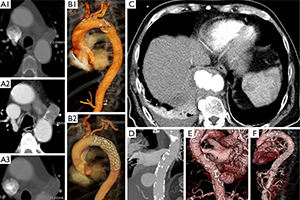Arch and access vessel complications in penetrating aortic ulcer managed with thoracic endovascular aortic repair
Abstract
Background: To analyze our experience and to describe access and arch-related challenges when performing thoracic endovascular aortic repair (TEVAR) for penetrating aortic ulcers (PA
Methods: This is a single-center, observational, cohort study. Between October 2003 and February 2019, 48 patients with PAU were identified; 37 (77.1%) treated with TEVAR were retrospectively analyzed. Primary major outcomes were early (<30 days) and late survival, freedom from aortic-related mortality (ARM), and a composite endpoint of arch/vascular access-related complications.
Results: On admission, 17 (45.9%) patients were symptomatic with 4 (10.8%) presenting with rupture. In-hospital mortality was 8.1% (n=3). We observed 10 (27.0%) arch/access-related complications. There were 4 (10.8%) arch issues: 2 transient ischemic attacks and 2 retrograde acute type A dissections which required emergent open conversion for definitive repair. Access issues occurred in 6 (16.2%) patients: 3 (8.1%) required common iliac artery conduit, and 1 (2.7%) patient required iliac artery angioplasty to deliver the stent-graft. In addition, 2 (5.4%) patients developed access complications which required operative repair [femoral patch angioplasty (n=2), and femoral pseudoaneurysmectomy (n=1)]. Arch/access-related mortality rate was 5.4% (n=2) and median follow-up was 24 (range, 1–156; IQR, 3–52) months. Estimated survival was 87.1% (standard error: 0.6; 95% CI: 71.2–84.9%) at 1 year, and 63.3% (SE: 0.9; 95% CI: 44.1–79%) at 4 years. Estimated freedom from reintervention was 88.9% (SE: 0.5; 95% CI: 74.8–95.6%) at 1 year, and 84.2% (SE: 0.7; 95% CI: 67.3–93.2%) at 4 years. No arch/access-related issues developed during the follow-up period
Conclusions: Our experience confirms that vascular access and aortic arch issues are still a challenging aspect of performing TEVAR for PAUs. Our cumulative 27% rate of access/arch issues is lower than previously reported due to both technological advancements and meticulous management of both access routes and arch anatomy.
Cover






